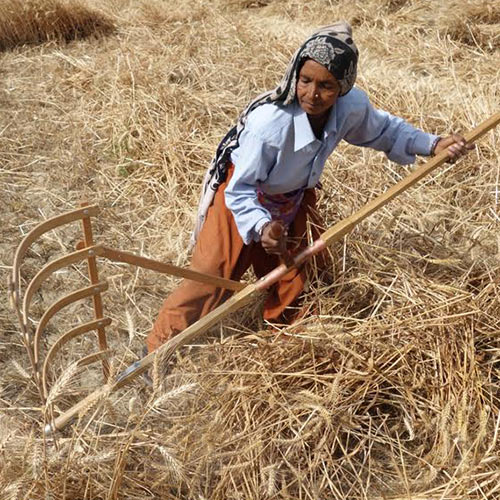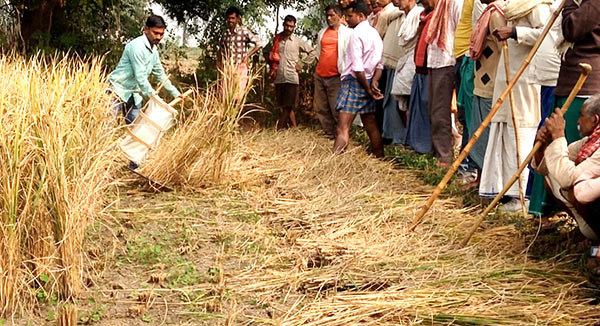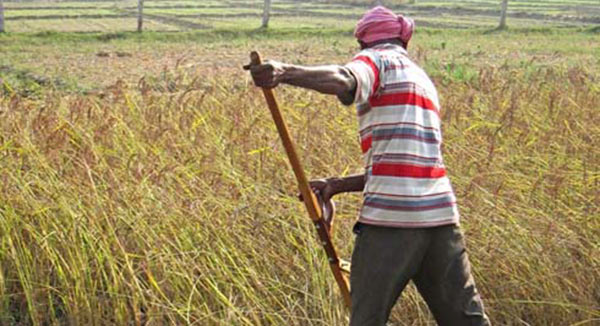Scythe Works Without Borders
The scythe works without borders, literally.
OUR MISSION:
To introduce the use of scythes for gathering fodder and harvesting cereal crops in regions where sickles (or machetes) are traditionally used, thereby increasing productivity and reducing drudgery.
OUR VISION:
Scythes are a form of appropriate technology that can make significant improvements to the lives and livelihoods of small farmers and agroecologists worldwide, increasing their personal capabilities, self-reliance, and resilience, while avoiding fossil-fuel burning and debt-creating mechanization.
“I believe that innovative minds backed up by adequate practical skills
are the backbone of a resilient and flourishing village life”
Benefits
of the scythe
-
increases the productivity of the harvest — for cutting, scythes are 6 to 10 times faster than sickles
-
reduces the labour shortages during harvest months
-
improves health by working in an upright position, instead of squatting or bending
-
eliminates the pollution, fuel, and maintenance costs that come with mechanized harvesting
-
clearly cost-efficient for many applications
Scythe Works Without Borders explores and demonstrates how scythes may be used for various applications, offering beneficial and sustainable solutions. Each country in the Global South is facing its own set of challenges which need to be addressed accordingly.
For instance, in Sub-Saharan Africa, the scythe is used to cut grasses for haymaking to sustain livestock through the dry season, and thus contributes to food security and the local economy. In India, vast fields of grain are harvested by sickles, whereas the use of scythes is helping speed up the harvest and ease the physical demands of this job without increasing the carbon footprint or requiring a great financial investment.
The demographic shifts from rural areas to the urban centers is not always due to a lack of work in the fields. The politics of food, globalization, and media exposure play a big role in this trend. Many villagers, especially young people, are attracted to cities where they believe there are easier ways to provide for themselves and their families.
In some situations, the emerging ‘opportunities’ in the cities are responsible for acute shortages of labor in the rural areas, especially at the harvest time. This obviously doesn’t contribute to food security but promotes the opposite.
Under the banner of education, we often envision an illiterate woman learning to read and write, or a young person studying high-tech skills. These are important, but perhaps not enough emphasis is placed on vocational training in the rural areas. Undeniably, it is important to innovate, to strive for more sustainable ways, and make improvements that are kind to all life. However, it is also important to pass on the knowledge and skills that help us to sustain ourselves in a dignified manner, without depleting non-renewable resources for generations to come.
“Innovative minds backed up by adequate practical skills are the backbone of a resilient flourishing village life.”
It is with these thoughts that I would like to explore the possible contributions of scythes in the Global South.
A BRIEF BACKGROUND STORY:
During my travels in Northern India and Nepal 2007, while watching local farmers and their children using sickles, it occurred to me that a scythe would enable them to accomplish the task much faster and with less exertion.
Upon my return to Canada, I visited my brother Peter Vido (of ScytheConnection) at his farm in New Brunswick. Peter is well known in the scythe circles for his dedication to bringing out the best in a scythe. He was traveling to Europe extensively, gathering knowledge from various scythe manufacturers and users — seeking improvements to efficiencies not only in the field but also on the manufacturing side.
On Peter’s farm, I got my initial training in the use and maintenance of scythes. I received his continuous and valuable support as he recognized what a great contribution the scythe could make in the lives of small farmers around the world. Until his passing in June 2018, Peter was actively working on introducing the scythe in the regions of Latin America. I am deeply grateful to my brother for sharing his knowledge.
In 2012, the Scythe Project in Nepal (SPIN) was my first attempt to introduce the scythe to Nepali farmers. Despite my efforts, there was a lack of common vision between me and the local co-organizers, and SPIN failed in its intention of putting the scythe to use there on a larger scale.
However, three years later in 2015, my YouTube video about the project in Nepal came to the attention of Gudda Bhaiya — a visionary organic farmer/ businessman in Kanpur, India — and he contacted me while I happened to be traveling in India during a scythe-related trip. We managed to meet for one day at the very end of my trip, and he was impressed with the demonstration done in his field.
In the spring of 2016, Gudda Bhaiya invited us back to India to demonstrate the utility of the scythe during the wheat harvest. We traveled to many villages to do demonstrations, and the video we made during this trip went viral.
After that trip, I continued my assistance to VIKALP, consulting from a distance in Canada, as they actively promoted scythes in India, giving demonstrations and sharing the essential skills with new users and future trainers.
In 2017, I went back to India to give further consultation on the design modifications to the snath and cradle, and selecting and sourcing of the suitable blades and other equipment. The snaths, cradles and all the accessories are made locally, with only the blades being imported (directly from the factory). This is the result of a shared vision and a close collaboration between SCYTHE WORKS (Canada) and VIKALP (India).
Scythe Works Initiative in India
Over the years, when considering and planning the scythe projects in developing countries, I’ve paid close attention to the scythe equipment, thinking about how it can be best adapted for the local usage. Currently, the Scythe Works designs for snaths and cradles are being successfully implemented in India. I always encourage the use of local materials and the utilization of local skills wherever possible. I strive to come up with the most suitable options for the given circumstances, and I freely share my insights.
SUPPLIES designed for the outreach projects:
ScytheWorks Snath Design
ScytheWorks Cradle Design
Choosing the Blade
VIKALP Scythe Kit, now available in India
"Could The Scythe Help?" the article by Peter Vido
Some thoughts on meaningful tool assistance
in the ‘underdeveloped’ regions
by Peter Vido
Incalculable kilocalories of motive energy, potentially at peoples’ disposal towards meaningful ends, have been squandered because (among an array of other reasons) a significant portion of the global workforce has not been provided with the most suitable tools for the work demanded of them. The necessary balance has simply been drawn from their bodies, and untold thousands of lives have been made barely bearable as a result of this poor energy-exchange ratio.
There are currently millions of hoe, sickle, or machete-swinging peasants around the globe who labour far harder than should be needed in order to prepare the seedbed in the fields, harvest their staple grains or cut forage for livestock. Work-hardened as they may be, they still abuse their bodies unnecessarily.
In many cases, the availability of an improved tool would allow them to accomplish the work easier AND several times faster. By ‘improved tool’ I do not mean a machine, but rather evolutionary and ergonomic design improvements within the realm of human-powered tools – be they for working soil or cutting everything from tender grass to sizable trees. Sometimes the improvements could be relatively minor during the production stage but would yield multiples of benefits during the years of the tool’s intended use. I have in mind the often- neglected details like longer (mostly) or shorter (sometimes) hoe and ax handles, and (in the majority of cases) their ergonomic features. A more penetrating edge profile of both hoes and axes (with due consideration to specific niches of use) could spell a difference akin to fuel consumption between an average American car fleet of 30 years ago, and the Prius of today.
However, this article is written specifically with focus on the scythe, a tool with 2500 years of history, and one that in some regions of this globe continues to be used and deeply appreciated. It is a tool that does not require appreciably more non-renewable resources to produce and maintain than does a machete. Yes, it calls for more skill — on both ends of the spectrum — its production and its application. However, human capacity for learning is unlimited; fuel to power machines is not…
In any case, I have long been convinced that had the scythe been sensibly introduced (by competent-for-the-task people) several generations ago as a partial, niche-specific alternative to the sickle and/or machete in all the ‘developing’ regions of the world, then the existence of millions (yes, millions) of peasants would have been much easier.
In recent decades — sometimes under the cloud of ignorance and/or a profit-oriented agenda and pretense to ‘help the poor’ — machines of all sorts have been introduced into the most remote and pristine corners of this precious Earth where the inhabitants do not yet understand the long range side effects and the price their children will need to pay for the present ‘convenience’. Consequently, a chainsaw is put into the hands of a previously machete or ax-swinging Latino man, and the tropical forest falls much too fast… Or a Chinese-made petrol-powered grain harvester is brought into the mountains of Nepal, and the peasants become the credit system’s slaves. Such examples are countless. Widespread ‘sustainability’ rhetoric notwithstanding, the Life-destroying process continues at an alarming pace.
If well-designed for the respective task (and thereby automatically efficient) hand tools comprised the ‘help packages’, the madness could at least slow down — because tools powered by the energy springing from a human body offer their users more opportunity to reflect on our relationship with Creation. As a result, perceptive people may reconsider to-them-available options, and take the less-abusive path.
The scythe fits into the category of what I think of as ‘reflective tools’ about as well as any other.
Still, I am not suggesting that the scythe ought to replace the machete or the sickle for all their respective kinds of work. The machete is surely one of the most multitasking steel tools our civilization has invented, and its usefulness in tropical regions is notable.
However, it is often used for tasks (such as cutting down sizable trees) where an ax would be more efficient. Similarly, for harvesting forages, whenever cutting them close to the ground is preferable or advantageous, a good scythe can easily outperform the machete.
The situation is similar with sickles. For small-scale grain harvesting under many conditions and cultural contexts, the sickle is the most appropriate tool. But in large fields, for cutting leftover straw (after the heads were first removed with a sickle), and most certainly for harvesting significant amounts of green forages, the scythe clearly has no equal among the human-powered tools. Operated strictly by the energy supply in the form of its user’s natural food intake — it should relatively easily yield an adequate amount of cut forage to justify the effort. (If it does not, the tool’s adjustment, edge maintenance or the manner of operating calls for refining).
On the other hand, whenever supplemental fodder is to be prepared (often during relatively short windows of time) for harsh winters or extended periods of drought, the EROEI (energy returned on energy invested) relationship of a machete or a sickle is not nearly as favorable.
Consequently, inadequate animal feed supply is a chronic condition throughout large areas of the world, and somebody always suffers. Initially it is the livestock undernourished by their inadequate diet (thousands of domestic animals presently die every year for this very reason) and, by extension, their keepers relying on the milk/meat supply which has interim been seriously reduced.
There is still another issue to consider, and that is poisonous snakes and scorpions. Having now lived for so many years in a region where there are no poisonous snakes at all, I had missed this altogether. During the four or so months of frost-free season we always walk (and mow) barefoot nearly all of the time, including when mowing in the fields. We do have plenty of snakes, but they are not poisonous, and our concern has always been that we do not harm them with the blade. Usually they move back into tall grass as we approach, without us even seeing them. Occasionally (when they perhaps decide to lay low instead of run) we do nick one, but console ourselves that such wounds can heal. Even more rarely, I have cut off a snake’s head — cleanly and completely — and whenever that happens, I apologize to the snake’s spirit…
It is not easy for me to imagine what version of Life-respecting attitude I would embrace IF the grass we need to cut in order to feed our animal friends was teeming with poisonous snakes or scorpions. But I can certainly state that using a cutting tool with a short handle is not what I would choose, if other options were available. And of course they are, and had been for a long time before the first machine was ever invented.
During the present times of relative plenty, one option is a machine, be it one operated from a seat of a tractor, or the now so widespread “weed eater”. And though I have long been puzzled by the apparent fascination with them, with this valid concern regarding snakes entering the equation, I can begin to appreciate why so many farmers in India, for instance, would be willing to strain their family resources in order to become dependent on a tool which needs continuous supply of petrol and replacement parts.
Still, I think that it is unfortunate that many thousands of farmers around the globe have not been given the opportunity to try a grass-cutting blade on a long handle, before they succumb to the ‘drug of the machine’, or continue struggling with a bent back while also in close proximity to poisonous snakes.
With the above reflections in mind, I consider it a meaningful undertaking to present the scythe into the machete and sickle using regions where the motorized alternatives to traditional tools have not yet (or not quite) done the long-term cultural and economic damage they are often known to cause.
Having introduced (directly or indirectly) this old tool into many new hands in the Western part of the world, but having for the most part only second-hand experience doing so in the Global South (by way of books, reports and conversations with those ‘in the field’) I am not qualified to present some broadly applicable ‘blueprint’. Even so, I wish to offer some food for thought.
The bottom line of my message is this:
Because it takes a great deal of combined energy to transport live scythe teachers into faraway regions, due thought should be given such an undertaking. It should be done well, or left alone, in hopes that someone else might materialize who will do it well.
An outline of one basic approach that I think may lead to good results, follows below. (Feedback from individuals with more actual experience in this field would, of course, be very much appreciated.)
1. The role of workshop organizers
By organizers I mean people who are already actively involved in some aspect of agricultural aid in the area of the scythe-introduction-to-be, who preferably speak the language to a useful degree and understand the local etiquette or taboos. These could, of course, be natives of the respective country whose ability to communicate in English is very good. I believe that in these organizers’ hands lies a significant portion of a project’s success. Please keep in mind that I am not suggesting a strictly regimented program, but rather an approach that is pre-mediated, wholesome, and with little room for blunders. Beyond that it should be creative, niche-specific and enjoyable. Lacking those characteristics, the project may already start on a shaky footing.
Some ideas:
a) The organizers ought to carefully assess the cultural/psychological and economic constraints that are likely to make the challenge of the undertaking greater than expected, or even impossible to meet. (In some cases, especially if the continuation of the efforts seems unlikely, it may be wiser to leave that particular region alone, and instead focus one’s energy on planting seeds into already more fertile soil.)
b) Some familiarity with the scythe, even if only theoretical (terminology used, etc.) would be helpful; a sort of ‘homework’ the organizers could spend some time on beforehand. To this end we (the ScytheConnection, ScytheWorks and ScytheConnected folks, along with a few friends) have been working on two versions of a field manual, soon to be available as a pdf. file for a free download. The text of one version is trimmed down to what we perceive is the absolute minimum of words. It is this version that should precede the teachers as a ‘pre-introduction’ of sorts, as it is easily translatable into the language of the respective regions. The local teachers-to-be can use it as helpful reference, and pass it further afield.
The second version is considerably expanded (text wise) and meant for those with good command of the English language and more than a passing interest in the subject. Both versions contain large diagrams.
c) Scouting suitable areas for the workshop, vegetation-wise, is rather imperative. Much surprise and disappointing unpreparedness can be prevented if the nature of the terrain (and the physical properties of the plants and their density) is communicated beforehand to the teachers (who would bring along the equipment and must make decisions as to its niche-specific appropriateness without actually seeing the terrain first).
This important consideration has been notoriously neglected by the average attempt at introduction.
On behalf of the uninitiated, I want to point out that scythe blades are manufactured not only in different lengths (from 40 to 90 cm); there is also a difference in weight per length (which translates into a difference in strength). Among them all, some are ill-suited for certain conditions, and a fundamentally poor choice in this regard can also spell a difference between success and failure of the venture.
2. The often-unperceived challenges.
It may well be not only a different challenge, but a greater one, to pass the scythe use know-how to a seasoned machete user, than to a Western city dweller who has hardly worked with cutting tools of any sort.
It is a variation of the classical Zen case of the “full cup”…
Even though the reasons for this are several, and play into each other in a variety of ways, they can be identified and (for the sake of temporary convenience) isolated from each other. Doing so would likely make the obstacles clearer, and ease the task of finding “The Path of Least Resistance” through the jungle — so that the thousands of good people waiting on the other side could benefit.
On a purely technical level, the two most obvious ‘obstacles’ are:
1. The instinctive / body-ingrained tendency of the machete users to “chop”.
(Consequently, instead of learning the slicing scythe stroke properly right from the start, the scythe often ends up being used as if it were a crooked machete on a long handle. This is an utterly inefficient manner in the case of swinging this tool.)
2. The lack of attention to edge maintenance.
(While many other common tools — axes, machetes, hoes or shovels — can still function somewhat satisfactorily with neglected edges, the scythe blade’s usefulness drops drastically in relation to the lessening ‘keenness’ of its edge.)
Both of these established ‘habits’, unless addressed with deserved attention, make significant success of scythe introduction unlikely. (I expand on this topic in Note 2.)
3. Qualifications of the visiting teachers
On this topic, I wish to emphasize that whenever I refer to someone (including myself) as a ‘teacher’ I have in mind merely a more advanced student of the subject. Furthermore, any so-called ‘teacher’ can, at best, function as a sort of bridge by means of which bits of knowledge can cross metaphorical rivers so that the learning process continues.
That said, individuals volunteering for the task of passing on the scythe-using skills ought to be competent in using this tool under a diversity of situations — from wide expanses of meadow-like grass to a patchwork style of gardening in areas where obstacles (bushes, stones) need to be mown around.
Furthermore, during the workshops they need to demonstrate the action of at least two differently shaped edges:
a) One that is more durable and thus damage-resistant, but less efficient at cutting green, juicy plants. (Such an edge should still be keenly honed, but being thicker, should not readily crack or crumble upon reasonably guided contact with obstacles like tough woody stems or rocks.)
b) A second one that, as opposed to the first, has a thinner profile and cuts soft plants with such ease that the difference is readily apparent to anyone trying out the two respective scythe versions.
It must be kept in mind that maintaining the second edge, the one with greater forage-cutting efficiency, requires correspondingly more skill and awareness in use. If the students are not ready for that level of tool use attention, mentally or otherwise, it may be somewhat counterproductive to attempt it at all. However, the most fitting compromise can be found for every set of circumstances, and that is exactly what those guiding the learning process need to be able to ascertain.
Furthermore, the teachers will also need to help the students understand, both in theory and practice, how to achieve these two basic edges, plus variations in-between. It may be that only one of the variations is readily applicable in that respective locality, and this is something that must be decided during the in-field sessions, and then focused upon — collectively by the group — after a couple of days of the initial practice but before the imported teachers leave.
As a side note: Many thousands of blades presently in use in the ‘third’ world are functioning far below their potential, even though they have sometimes been used for several generations. In some cases they are too short, too long or too heavy to be as efficient as a scythe blade could be, again, in that respective locality. Often enough they are put on snaths of inferior design or size, and sloppily fine-tuned. But perhaps most importantly, adequate sharpening skills were not passed along by those who were involved with the initial introduction. Notorious lack of suitable grindstones along with the fact that the alternative — the art of shaping the edge by means of common hammers (“peening”) — was never taught, this continues to contribute to situations where the EROEI is significantly less than it ought to be. (Also addressed in Note 2.)
In any case, I consider learning how to peen (plus make repairs as soon as damage to the edge happens) to be rather paramount, and would hope that all teachers are in agreement.
4. Equipment.
Teaching students the basic principles of making snaths out of local material is, to me, another given. By local material I mean wood, not steel.
The attachment hardware can readily be made out of scrap steel by local blacksmiths, but should steel be unavailable, hand-made cordage would do.
For the edge-shaping tools — the anvils and hammers — steel is as irreplaceable a material as that from which the blade itself is made. Of course, one anvil / hammer set can serve the shared purpose of many mowers residing within a close locale. It would in fact be best if the most competent two or three persons in this regard functioned as ‘the scythe-maintenance crew’ for the whole village.
The blades, however, are a different issue. This is the one item that I recommend be brought into the region. The idealistic notion of certain well-meaning individuals representing permaculture, ‘intermediate technology’ and similar movements — that local blacksmiths can seriously produce scythe blades to meet the overwhelming need is, for the time being, a counterproductive trap. I have field-tested two samples of such attempts, and know of others; all were failures… Any of the few scythe factories around the globe can make a better-functioning blade in a fraction of the time than it would take a village smith. (By fraction I mean 30, 40 or more times faster!) That level of “local self-reliance” may well become desirable or necessary in the future and deserves some thought. For now, however, is utterly impractical. Should we honestly choose that level of ‘sustainability’/’local self-reliance’ we may well begin a serious conversation on the plausibility of return to the age of stone tools, and begin it soon…
5. Further preparatory steps
As has been proven enough times, both in Europe and overseas, a somewhat haphazard public/village demo, followed by an open invitation to a scythe course is usually relatively unsuccessful; only a small fraction of the volunteer participants end up learning enough to make good use of the tool for even their own purposes, never mind passing on the skill (at any acceptable standard) to others.
Instead, I suggest that the initial students from the local population (the scythe teachers-to-be) are carefully selected well beforehand, preferably with help of the elders of that village, who are intimately familiar with the personalities of people they watched growing up. The new concept and purpose of the course has to be properly explained to them, as well as to the potential students, by someone whom the community has come to respect. (I surmise that if the elders were fundamentally opposed to the introduction, it may well be best to leave that village/region alone.) Alternatively (or in addition), local agricultural representatives — if they were not already ‘high-jacked’ in name of “progress” by machinery dealers — can often be of invaluable help. Getting in touch with them well in advance is certainly to be recommended. While presenting the case to both (the elders and the agricultural representatives) some video material, if access to a computer is available, would be highly useful.
Secondly, I think that women deserve to be considered for the role of local scythe teachers more than has generally been the case. Over the years of working with males or females, as well as mixed groups, I have concluded that, on average, women are better students. They seem to listen more carefully and have less of a tendency to act as a ‘show off’. What does not come as naturally to women is the sharpening, probably because in most cultures it was traditionally men’s job. But, given a little more time, most of them can learn it just the same.
Consequently, at least in the regions where the cultural paradigm does not object to women taking on such a role, I personally would choose a combination of 75% women and 25% men as the ideal mix for the initial groups of students. To be yet more specific, girls between the age of 10 to 15 and old(er) women of a not too strong physique would make the best local demonstration actors. In other words, a group which by mere appearance makes it obvious that to operate a well-tuned scythe does not require much strength, and can be sustained for several hours without causing undue pain or long-term damage to physiology of the body.
Thirdly, I’d prefer to focus attention on one small group at a time. Two competent instructors with a clearly laid out plan, and a few different blades (that together would demonstrate the basic variations of fitting and application) should be able to train 4 students fairly well in about 4 days. That includes learning how to make a single-grip snath from scratch, and a grasp of the basic snath- and blade-fitting concepts. Additional requirements would be a good interpreter, suitable terrain and undisturbed surroundings. (Bystanders watching is a disturbance, for instance.) By suitable terrain I mean one where the vegetation provides opportunities for mowing larger areas (using a longer blade) as well as ‘obstacle courses’ where the forage is interspersed with rocks and bushes. Moving to different locations as the course progresses in order to practice the variations should be considered.
On the 5th day, I would let the group work on their own, with one of the instructors in the proximity, watching but not intervening). The students should by that time be learning to recognize shortcomings in the performance of their comrades, respectfully voice them, and thereby begin the role of instructors. Another day of ‘touch ups’ (if the time frame allows, preferably after a few days of each student working at home on their own) should make this group ready to pass the skill along to others in their region.
By this approach, four such groups could be readied within a month (or three in a month, if the last week is devoted to refining details with everyone). The resulting accomplishments would thus justify the combined energy input needed for the organizing of it all, and the instructors’ travel.
Further reflections of merit.
Harvesting of Grains
Beginning ones scythe experience with the harvesting of grains is somewhat analogous to “putting the cart before the ox”. I am fundamentally not in favor of it. The addition of a grain cradle attached to the snath adds considerable complexity to the learning process. Whenever the stalks do not fall as they should, it is difficult for a novice to identify where the trouble lies. Is it the manner in which the blade is guided, or is it the cradle adjustment instead? Among the wide variety of cradle versions, the ones that can be realistically expected to be locally made do need to be adjusted differently for not only different crops but also in view of the individual conditions of respective fields. It first takes experience and then patience to get this right.
In areas where larger-scale grain harvesting is the eventual aim of scythe application, a demo certainly has merit, and the most talented of the students could be given special attention in this regard — but not in lieu of first learning the basics of scythe use really well. Initially the students ought to be offered an empowering experience and such could be best obtained in a field of well-standing and relatively young grass. One good day (after the preliminaries) would suffice for that, and would be time well spent.
In any case, I’m sure that in old Europe everyone who picked up a scythe with a cradle attached to it was already quite competent in using this tool for cutting grass — and that is what I recommend as the initial aim of every new introduction. According to some feedback I have received on this topic, in certain situations it is impractical. For instance, there may be a rice paddy to demonstrate the use of a cradle scythe on, but no grass available in the same location to practice the technique without the cradle first. Yes, obstacles abound. But without first recognizing and then surmounting them, the holy grail of ‘sustainability’ will remain just beyond the next curve in the road…
The Overall Project’s Timeline.
I think that bringing only a few scythes into a region where nearly everyone is a farmer (and thus could well use one) is analogous to a story of an Avatar manifesting only a few fish, while a thousand hungry mouths are standing in line to be fed, and telling the people that he will be back next year with more miracles…
It should then go without saying that I do not approve of the snail’s pace that many scythe introduction attempts consider “OK”, or even ‘inevitable’. What typically happens in these cases is that sponsors for the project are first sought, and from the donated money the initial batch of equipment is purchased — more often than not somewhere in the ‘West’ and possibly at the respective country’s retail prices, with some meager discount. Then an individual or group take along a dozen or two complete scythe units (but often less), conduct a demo and/or a short course and depart, leaving the scythes behind. The well-meant intent is that they will be back ‘next year’, after another collection plate is passed around so more scythes and plane tickets can be bought. Sometimes such plans do not materialize, but even if they do — a year is a very long pause. If more equipment is desired in the interim, it is often found either cost-prohibitive with respect to local economy, or no ready source seems available at all. Meanwhile, the few scythes left behind must be shared, which may be a nice ideological principle but hardly a practical one. (Note 3.)
Supply and Costs.
Assuming that the initial introduction shows prospects of being successful and quickly stimulates further interest within that region, a question must be asked well in advance, about whether a dependable source and distribution system of reasonably priced blades of acceptable quality will be available. Presently, this is still the case, BUT in the long run it is by no means a given. The continuation of many optimistic but insufficiently pre-meditated attempts at scythe introduction nosedived for this reason, especially, it seems, in Africa. The people involved generally sum it up in one of two ways — the African farmers just can’t afford a scythe, or it simply is not available there.
As for “unaffordable” — I think that given the unprecedented challenges facing these cultures (as well as us all), they can actually ill afford not to purchase and make use of scythes. The variation in affordability is certainly an issue but is usually due more to other factors than is generally assumed. The exclamation that “these people are too poor to buy a scythe” — while referring to cultures where everyone owns a sickle — can be balanced by the old Mid-Eastern maxim “I am too poor to buy cheap tools”. (‘Less well-suited’, ‘poorly designed’ or ‘inefficient’ could, of course, be substituted equally well for “cheap”.)
Some hard-to-dispute evidence implies that, in the long run (and where applicable), the scythe is decidedly a ‘better deal’. Here is why:
(a) To begin with, at FOB (factory’s door) prices an average scythe blade does not cost any more than roughly twice the price of an average forged sickle or a machete (Note 4).
(b) Depending on the manner of maintenance, a scythe blade can outlast its ‘competitors’ (sickle or machete) by a large margin; it can rightly be considered a ‘lifetime tool’.
(c) The magnitude of this cost relationship is further made plain by the fact that for each hour the scythe is swung, several times as much work can be accomplished as if a sickle is swung instead.
(Regarding (a) cost, and (c) hourly accomplishment, a similar relationship exists between the machete and the scythe when cutting forages close to the ground (not clearing brush or chopping a trail through a jungle.)
Now, due to numerous accounts to that effect, I am aware that in many countries scythes are not readily available. I emphasize the ‘readily’ because the distance between a scythe blade and a needy farmer’s hands is often not as great as imagined.
You see, there are actually more extensive areas of the globe where scythes have regularly been shipped to within the last hundred years (or longer) than those excluded — and I am not referring to all those one-time-small-lots ventures of the scattered samaritans.
A few concrete examples:
Regarding Africa — Algeria presently still receives scythe blades (mostly from Europe) in lots sometimes as large as ten thousand at a time. Morocco and Egypt have also been importing them for a very long time. I realize that the distance from North Africa to the rest of the continent is very far, yet less useful merchandise is regularly moving along those routes. Of course, finding something and having it delivered is one thing, while the resulting cost (especially of very small lots and the hands in-between raking in profits) is another.
Regarding India — There are 3 scythe factories (all under the management of one family) within relatively close distance to India — one in Turkey, one in Kyrgyzstan and one in Iran. The price/quality ratio of what they produce may be the best, globally. Why has some Indian entrepreneur with a kind heart not grasped the oft-expressed need to put a good scythe into the hands of the thousands of laboring India’s women?? Or why have not the various small-scale agriculture oriented activists/analysts/observers brought this issue to someone’s attention; someone who can ‘move mountains’?? I have no answers to these questions, but each time I hear yet another crying voice from India, I keep re-asking them…
Re. Latin America — ever since that continent was mostly conquered, its gold and silver carted off to Europe, its cultures and peoples decimated, scythes have been used by some European settlers in various small niches between Northern Mexico and Tierra del Fuego. A few small scythe-making enterprises set up by European immigrants had earlier existed in Brazil (and possibly elsewhere (Argentina, Chile?). In the end, the tool-making giant – Tramontina of Brazil – was the last one on that continent to produce scythe blades. I was told by the manager that they quit the production (2 years ago) because they “could not compete, in quality, with the European imports. (please note how his qualified bird’s eye view contradicts the oft-expressed notion that common man’s tools ‘must’ be cheap, rather than well designed and well made…) Tramontina still offers scythe blades today, but those are made in Italy (actually the best on the world market).
To sum up: What no assistance organization appears to have done so far — assuming that one existed which grasped the merits of the scythe (and I’ve not been privileged to find one so far) — is help set up various cooperative supply ventures that would establish contacts directly with the factories, distribute a combined bulk order among a few strategic locations throughout a continent or a country, and agree to sell them to educational and/or otherwise meaningful projects at minimal mark-up above the combined costs (including transport, etc.) With such an arrangement, I believe, the scythes would not be ‘cost prohibitive’.
Scythe Initiatives in the Global South
India 2017
An implementation of the scythe in India is well underway. The scythe is successfully used for grains harvest as well as for gathering fodder. Watch helpful instructional videos on YouTube.
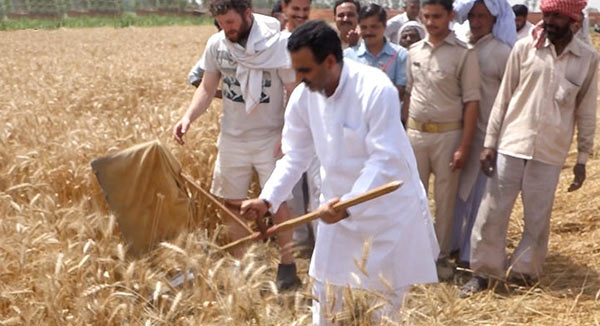
India 2016
Back in India for the winter heat harvest, Scythe Works initiative.
- Scythe Initiative In India – video presentation
- Sowing seeds for a scythe revolution by Sy Schotz
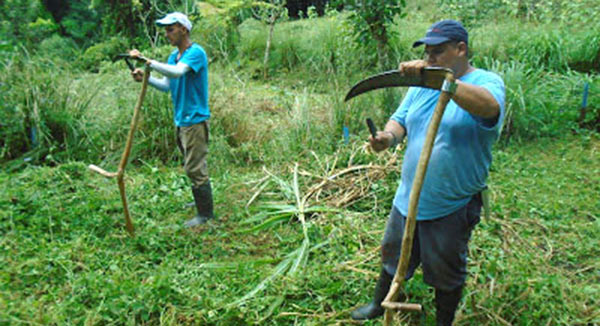
Costa Rica 2015
Canadian ScytheConnection found a good connection in Costa Rica
Inctructor: Peter Vido
India 2015
In a search for a good connection: Alexander’s trip to India with the scythe in hand.
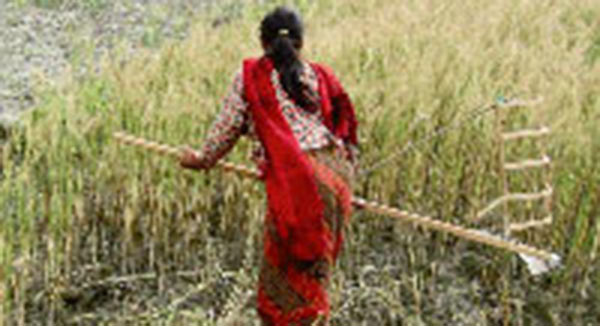
Scythe Project In Nepal (SPIN) 2012
Canadian project of ScytheWorks in cooperation with HPC and ICO.
Inctructor: Alexander Vido
- Why SPIN makes sense – video presentation
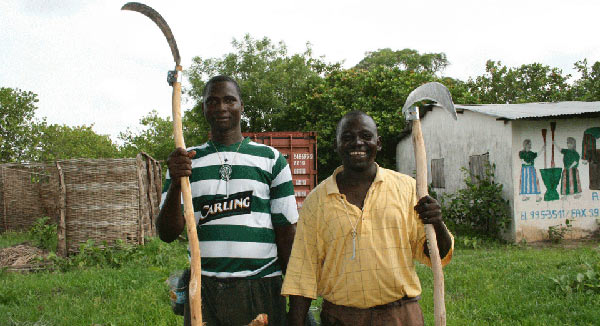
Scythe Project in Senegal and Gambia
Danish initiative in Senegal is part of “Bicycles for Senegal”
Inctructor: Jens Lykkebo and friends
Embracing new skills leads to empowerment, selfsufficiency and resilience.

